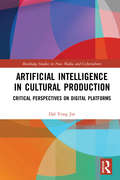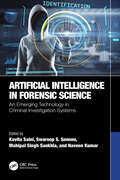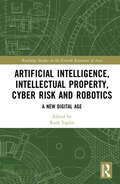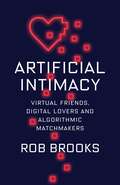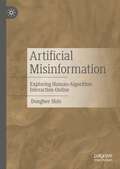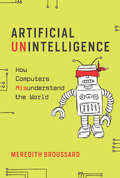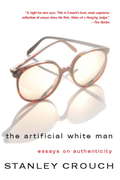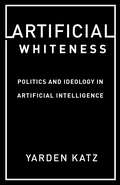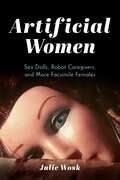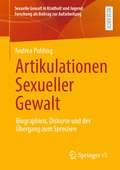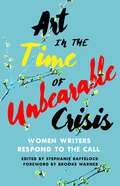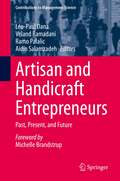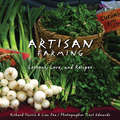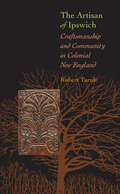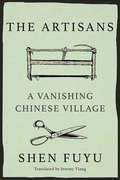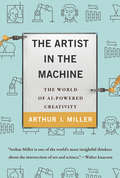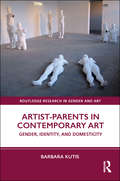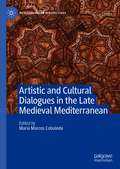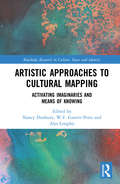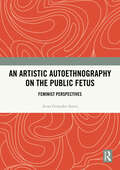- Table View
- List View
Artificial Intelligence Governance and the Blockchain Revolution (Artificial Intelligence and the Rule of Law)
by Qiqi Gao Jiteng ZhangThis is the first professional academic work in China to discuss artificial intelligence and blockchain together. Artificial intelligence is a productivity revolution, and its development has a significant and profound impact on global changes. However, at the same time, its development also brings a series of challenges to human society, such as privacy, security, and fairness issues. Therefore, the significance of blockchain is even more prominent. Blockchain is a revolution in production relations, which will propose important solutions to the challenges of privacy, security, and fairness that arise after the development of artificial intelligence. The book not only discusses the problems currently faced by the development of artificial intelligence, as well as the new opportunities and challenges that artificial intelligence brings to future global governance, but also explains the further development direction of the intelligent revolution from the perspective of blockchain.
Artificial Intelligence in Cultural Production: Critical Perspectives on Digital Platforms (Routledge Studies in New Media and Cyberculture)
by Dal Yong JinThis book offers an in-depth academic discourse on the convergence of AI, digital platforms, and popular culture, in order to understand the ways in which the platform and cultural industries have reshaped and developed AI-driven algorithmic cultural production and consumption. At a time of fundamental change for the media and cultural industries, driven by the emergence of big data, algorithms, and AI, the book examines how media ecology and popular culture are evolving to serve the needs of both media and cultural industries and consumers. The analysis documents global governments’ rapid development of AI-relevant policies and identifies key policy issues; examines the ways in which cultural industries firms utilize AI and algorithms to advance the new forms of cultural production and distribution; investigates change in cultural consumption by analyzing the ways in which AI, algorithms, and digital platforms reshape people’s consumption habits; and examines whether governments and corporations have advanced reliable public and corporate policies and ethical codes to secure socio-economic equality. Offering a unique perspective on this timely and vital issue, this book will be of interest to scholars and students in media studies, communication studies, anthropology, globalization studies, sociology, cultural studies, Asian studies, and science and technology studies (STS).
Artificial Intelligence in Forensic Science: An Emerging Technology in Criminal Investigation Systems
by Naveen Kumar Kavita Saini Mahipal Singh Sankhla Swaroop S. SononeArtificial Intelligence in Forensic Science addresses the current and emerging opportunities being utilized to apply modern Artificial Intelligence (AI) technologies to current forensic and investigation practices. The book also showcases the increasing benefits of AI where and when it can be applied to various techniques and forensic disciplines. The increasing rate of sophisticated crimes has increased the opportunity and need for the forensic field to explore a variety of emerging technologies to counter criminals—and AI is no exception. There are many current investigative challenges that, with ingenuity and application, can be helped with the application of AI, especially in the digital forensic and cyber-crime arena. The book also explains many practical studies that have been carried out to test AI technologies in crime detection, uncovering evidence, and identifying perpetrators. In the last decade, the use of AI has become common in many fields and now is an ideal time to look at the various ways AI can be integrated into judicial, forensic, and criminal cases to better collect and analyze evidence, thereby improving outcomes.
Artificial Intelligence In Medicine
by Peter SzolovitsThis book introduces the field of artificial intelligence in medicine, a new research area that combines sophisticated representational and computing techniques with the insights of expert physicians to produce tools for improving health care. An introductory chapter describes the historical and technical foundations of the work and provides an overview of the current state of the art and research directions. The authors then describe four prototype computer programs that tackle difficult clinical problems in a manner similar to that of an expert physician. The programs presented are internist, a diagnostic aid that combines a large database of disease/manifestation associations with techniques for problem formulation; expert and the Glaucoma Program which use physiological models for the diagnosis and treatment of eye disease; mycin, a rule-based program for diagnosis and therapy selection for infectious diseases; and the Digitalis Therapy Advisor, which aids the physician in prescribing the right dose of the drug digitalis and also explains its actions.
Artificial Intelligence, Intellectual Property, Cyber Risk and Robotics: A New Digital Age (Routledge Studies in the Growth Economies of Asia)
by Ruth TaplinArtificial Intelligence (AI) is the most rapidly developing technology in the current Digital Age, but it is also the least defined, understood and adequately explained technological advance. This book brings together a group of leading experts who assess different aspects of AI from different disciplinary perspectives. The book argues that robots are not living systems but the creations of humans who must ultimately be accountable for the actions of the robots that they have invented. Robots do not have ownership entitlement. The book uses Intellectual Property Rights cases, evidence from roboticists, cybersecurity experts, Patent Court judges, technology officers, climate change scientists, economists, physicists and those from the legal profession to demonstrate that while AI can have very beneficial uses for many aspects of human economy and society, robots are not living systems autonomous from human decision making. This book will be useful to those in banking and insurance, cybersecurity, lawyers, judges, technology officers, economists, scientist inventors, computer scientists, large and small companies and postgraduate students.
Artificial Intelligence, Social Harms and Human Rights (Critical Criminological Perspectives)
by Aleš Završnik Katja SimončičThis book critically explores how and to what extent artificial intelligence (AI) can infringe human rights and/or lead to socially harmful consequences and how to avoid these. The European Union has outlined how it will use big data, machine learning, and AI to tackle a number of inherently social problems, including poverty, climate change, social inequality and criminality. The contributors of this book argue that the developments in AI must take place in an appropriate legal and ethical framework and they make recommendations to ensure that harm and human rights violations are avoided. The book is split into two parts: the first addresses human rights violations and harms that may occur in relation to AI in different domains (e.g. border control, surveillance, facial recognition) and the second part offers recommendations to address these issues. It draws on interdisciplinary research and speaks to policy-makers and criminologists, sociologists, scholars in STS studies, security studies scholars and legal scholars.
Artificial Intimacy: Virtual Friends, Digital Lovers, and Algorithmic Matchmakers
by Rob BrooksWhat happens when the human brain, which evolved over eons, collides with twenty-first-century technology? Machines can now push psychological buttons, stimulating and sometimes exploiting the ways people make friends, gossip with neighbors, and grow intimate with lovers. Sex robots present the humanoid face of this technological revolution—yet although it is easy to gawk at their uncanniness, more familiar technologies based in artificial intelligence and virtual reality are insinuating themselves into human interactions. Digital lovers, virtual friends, and algorithmic matchmakers help us manage our feelings in a world of cognitive overload. Will these machines, fueled by masses of user data and powered by algorithms that learn all the time, transform the quality of human life?Artificial Intimacy offers an innovative perspective on the possibilities of the present and near future. The evolutionary biologist Rob Brooks explores the latest research on intimacy and desire to consider the interaction of new technologies and fundamental human behaviors. He details how existing artificial intelligences can already learn and exploit human social needs—and are getting better at what they do. Brooks combines an understanding of core human traits from evolutionary biology with analysis of how cultural, economic, and technological contexts shape the ways people express them. Beyond the technology, he asks what the implications of artificial intimacy will be for how we understand ourselves.
Artificial Misinformation: Exploring Human-Algorithm Interaction Online
by Donghee ShinThis book serves as a guide to understanding the dynamics of AI in human contexts with a specific focus on the generation, sharing, and consumption of misinformation online. How do humans and AI interact? How is AI shaping our understanding of ourselves and our societies? What are the interaction mechanisms that govern how humans and algorithms contribute to misinformation online? And how do we bridge the gap between ethical considerations and practical realities to make responsible, reliable systems? Exploring these questions, the book empowers humans to make AI design choices that allow them meaningful control over AI and the online sphere. Calling for an interdisciplinary approach toward human-misinformation algorithmic interaction that focuses on building methods and tools that robustly deal with complex psychological/social phenomena, the book offers a compelling insight into the future of AI-based society.
Artificial Unintelligence: How Computers Misunderstand the World (The\mit Press Ser.)
by Meredith BroussardA guide to understanding the inner workings and outer limits of technology and why we should never assume that computers always get it right.In Artificial Unintelligence, Meredith Broussard argues that our collective enthusiasm for applying computer technology to every aspect of life has resulted in a tremendous amount of poorly designed systems. We are so eager to do everything digitally—hiring, driving, paying bills, even choosing romantic partners—that we have stopped demanding that our technology actually work. Broussard, a software developer and journalist, reminds us that there are fundamental limits to what we can (and should) do with technology. With this book, she offers a guide to understanding the inner workings and outer limits of technology—and issues a warning that we should never assume that computers always get things right.Making a case against technochauvinism—the belief that technology is always the solution—Broussard argues that it's just not true that social problems would inevitably retreat before a digitally enabled Utopia. To prove her point, she undertakes a series of adventures in computer programming. She goes for an alarming ride in a driverless car, concluding “the cyborg future is not coming any time soon”; uses artificial intelligence to investigate why students can't pass standardized tests; deploys machine learning to predict which passengers survived the Titanic disaster; and attempts to repair the U.S. campaign finance system by building AI software. If we understand the limits of what we can do with technology, Broussard tells us, we can make better choices about what we should do with it to make the world better for everyone.
The Artificial White Man: Essays on Authenticity
by Stanley CrouchWhile not denying the distinct styles of different ethnic groups, columnist, novelist, essaying, and television commentator Crouch believes that some people have trouble seeking their own individuality because they are trying to follow a recipe for how to be an acceptable member of their particular ethnic group. In particular, he argues that empty-headed appropriation or assumed membership in a besieged elite like the white world is far different from inspired reactions to influences from outside of someone's class and ethnic convictions. The blues is his primary metaphor. Annotation ©2004 Book News, Inc. , Portland, OR (booknews. com)
Artificial Whiteness: Politics and Ideology in Artificial Intelligence
by Yarden KatzDramatic statements about the promise and peril of artificial intelligence for humanity abound, as an industry of experts claims that AI is poised to reshape nearly every sphere of life. Who profits from the idea that the age of AI has arrived? Why do ideas of AI’s transformative potential keep reappearing in social and political discourse, and how are they linked to broader political agendas?Yarden Katz reveals the ideology embedded in the concept of artificial intelligence, contending that it both serves and mimics the logic of white supremacy. He demonstrates that understandings of AI, as a field and a technology, have shifted dramatically over time based on the needs of its funders and the professional class that formed around it. From its origins in the Cold War military-industrial complex through its present-day Silicon Valley proselytizers and eager policy analysts, AI has never been simply a technical project enabled by larger data and better computing. Drawing on intimate familiarity with the field and its practices, Katz instead asks us to see how AI reinforces models of knowledge that assume white male superiority and an imperialist worldview. Only by seeing the connection between artificial intelligence and whiteness can we prioritize alternatives to the conception of AI as an all-encompassing technological force.Bringing together theories of whiteness and race in the humanities and social sciences with a deep understanding of the history and practice of science and computing, Artificial Whiteness is an incisive, urgent critique of the uses of AI as a political tool to uphold social hierarchies.
Artificial Women: Sex Dolls, Robot Caregivers, and More Facsimile Females
by Julie WoskWhat distinguishes humanity from artificial beings? What do constructed creatures tell us about ourselves? From sex dolls to Siri, talking Barbies to robotic mothers, Artificial Women explores the ways in which today's simulated females—both real and fictional—reflect and expose our own ideas about gender and female identity. Join Julie Wosk as she probes the realm of compliant sex workers, nurturing caretakers, genial servants, and rebellious creations in film, television, literature, art, photography, and current developments in robotics. These modern-day Galateas must embrace their own synthetic nature while also striving for authenticity and autonomy, all the while foregrounding gender stereotypes and changing perceptions of women and their roles. They embody the paradoxes and tensions that continue to arise in our increasingly simulated world, where the lines between the real and the virtual only continue to blur. As these "artificial women" become ever more lifelike, so too do the questions they raise become more provocative, and more illuminating of our own conceptions and conventions. Artificial Women pushes the boundaries of gender, sexuality, and culture studies to consider new digital technologies, artificial intelligences, and burgeoning simulations.
Artikulationen Sexueller Gewalt: Biographien, Diskurse und der Übergang zum Sprechen (Sexuelle Gewalt in Kindheit und Jugend: Forschung als Beitrag zur Aufarbeitung)
by Andrea PohlingNicht erst seit dem Jahr 2010 wird über das Thema der sexuellen Gewalt geforscht und gesprochen. Aber wie sprechen betroffene Menschen in biographischen Interviews über ihre Erfahrungen sexueller Gewalt in Kindheit und Jugend? Und wie gehen sie im Verlauf ihres Lebens dazu über, über diese Erfahrungen zu sprechen oder wenden sich davon ab? Die Studie leistet einen Beitrag zu einer erziehungswissenschaftlich ausgerichteten Gewaltforschung in Anlehnung an das Konzept der Artikulation. Sie zeigt auf, wie der Übergang zum Sprechen über sexuelle Gewalt in Kindheit und Jugend in diskursive und gesellschaftliche Verhältnisse einerseits sowie in biographische Erfahrungen und Bearbeitungsstrategien andererseits eingebunden ist. Vor diesem Hintergrund wird die Vielfältigkeit „des“ Sprechens über Sexuelle Gewalterfahrungen beleuchtet und verschiedene Modi der Artikulation Sexueller Gewalt vorgestellt. Auf der Grundlage von drei Falldarstellungen wird der Übergang zum Sprechen als mehrdimensionaler, nicht-linearer und relationalerProzess definiert.Die AutorinAndrea Pohling ist wissenschaftliche Mitarbeiterin an der Goethe-Universität Frankfurt am Main am Institut für Sozialpädagogik und Erwachsenenbildung. Ihre Arbeitsschwerpunkte und Forschungsinteressen sind Kindheits- und Jugendforschung, Forschung im Kontext der Themen Sexualität, (sexuelle) Gewalt und Diskurse, Methoden qualitativer Sozialforschung sowie forschungsethische Fragen und Spannungsfelder.
Art in the Time of Unbearable Crisis: Women Writers Respond to the Call
by Stephanie RaffelockArt keeps good alive in the worst of times. In the face of ugliness, pain, and death, it’s art that has the power to open us all to a healing imagining of new possibility; it’s art that whispers to the collective that even in the ashes of loss, life always grows again. That’s why right now, in this tumultuous time of war and pandemic, we need poets more than we need politicians. In response to the multitude of global crises we’re currently experiencing, editor Stefanie Raffelock put out a much-needed call to her writing community for art to uplift and inform the world, and the authors of She Writes Press answered. Art in the Time of Unbearable Crisis—a sometimes comforting, sometimes devastating, but universally relatable collection of prose, poetry, and art about living through difficult times like these—is the result. Addressing topics including grief and loss, COVID-19 and war in Ukraine, the gravity of need and being needed, the broad range of human response to crisis in all its forms, and more, these pieces explore how we can find beauty, hope, and deeper interpretation of world events through art—even when the world seems like it’s been turned inside out and upside-down. Proceeds: Our Commitment The collection of essays, poetry, and art in this book are meant to feed and nourish our hearts and minds. It’s what women do—we feed people. To that end, the proceeds from this work will be donated to the nonprofit World Central Kitchen, an organization conceived by chef José Andrés as a way to feed people affected by natural disasters and war.World Central Kitchen financially supports food banks and restaurants that provide free food throughout the world.
Artisan and Handicraft Entrepreneurs: Past, Present, and Future (Contributions to Management Science)
by Léo-Paul Dana Veland Ramadani Ramo Palalic Aidin SalamzadehIn handicrafts and artisanal products, industry has witnessed both a technological shift and a renewed interest among customers, especially after the challenges and limitations of mass production became evident under the COVID-19 pandemic. This book portrays the worldwide development of this trend, the nature of entrepreneurship in these industries, and the unique challenges and opportunities that entrepreneurs face. The book shows how these businesses are gaining a resurgence due to customers preferring ethical, regional, and climate-friendly options to fulfill their needs. The chapters focus on artisan entrepreneurs' contribution to society by not only creating businesses, but also in terms of tourism development. The book reiterates that artisan entrepreneurs enable crucial cultural connections with tradition due to their affinity to a region, city, village, or community. Small business and entrepreneurship researchers as well as policymakers in the cultural sector would benefit from this book.
Artisan Farming: Lessons, Lore, and Recipes
by Richard Harris Lisa FoxExplore the unique farming culture of New Mexico through stories, recipes, and photographs in this book of rustic artisanal living. Life is hard for the artisanal farmers of New Mexico—but they wouldn't have it any other way. They take pride in their land, their soil, their crops, and their families. Competition for business is friendly and cordial. Neighbors help neighbors, and community is key. They eagerly await the farmers markets not only to sell their wares, but to renew their friendships and swap stories of their mishaps, trials, and adventures. Laden with rich photos, ripe with human interest stories, and bounteous with tantalizing recipes, Artisan Farming explores this state's one-of-a-kind agricultural heritage and the revival of traditional, organic, and "artisan" farming. Readers will discover the small farms, farmers' markets, community-supported agriculture organizations, heritage seed exchanges, and other entries that have made the independent farming revival possible.
The Artisan of Ipswich: Craftsmanship and Community in Colonial New England
by Robert TaruleThomas Dennis emigrated to America from England in 1663, settling in Ipswich, a Massachusetts village a long day's sail north of Boston. He had apprenticed in joinery, the most common method of making furniture in sixteenth- and seventeenth-century Britain, and he became Ipswich's second joiner, setting up shop in the heart of the village. During his lifetime, Dennis won wide renown as an artisan. Today, connoisseurs judge his elaborately carved furniture as among the best produced in seventeenth-century America.Robert Tarule, historian and accomplished craftsman, brilliantly recreates Dennis's world in recounting how he created a single oak chest. Writing as a woodworker himself, Tarule vividly portrays Dennis walking through the woods looking for the right trees; sawing and splitting the wood on site; and working in his shop on the chest—planing, joining, and carving. Dennis inherited a knowledge of wood and woodworking that dated back centuries before he was born, and Tarule traces this tradition from Old World to New. He also depicts the natural and social landscape in which Dennis operated, from the sights, sounds, and smells of colonial Ipswich and its surrounding countryside to the laws that governed his use of trees and his network of personal and professional relationships.Thomas Dennis embodies a world that had begun to disappear even during his lifetime, one that today may seem unimaginably distant. Imaginatively conceived and elegantly executed, The Artisan of Ipswich gives readers a tangible understanding of that distant past.
The Artisans: A Vanishing Chinese Village
by Shen FuyuEvoking Studs Terkel, Shen Fuyu delivers a rollicking deep dive into working life in a small village in rural China, tracing the last 100 years of history.Born in Shen Village in Southeast China, Shen Fuyu grew up in a family of farmers. Years later, Shen, now a writer, returned to his hometown to capture the village&’s rich history in the face of industrialization. Through his own childhood memories and those of his ancestors, Shen resurrects the working life of Shen Village through interlinked stories of fifteen artisans as their lives intersect over the course of a century. While Shen's view of his hometown and his heritage is tinged with nostalgia, he does not romanticize it. Nor does he sugarcoat the backbreaking difficulty of life in rural China, but he still captures its small satisfactions and joys of loving one&’s work with a great deal of care. In an acerbic, earthy and unsparing style that swings from poignancy to comedy, sometimes within a single paragraph, Shen evokes the spirits of these workers--a bamboo-weaver and his beloved bull, a carpenter&’s magical saw, the deserter who became the village lantern-maker and a rebellious woman who beats up her own kidnapper. A reflection on the vicissitudes of small-town life during the epic shift from agricultural to industrial civilization, The Artisans vividly details the hardships, friendships and communal mythmaking of a disappearing community.
The Artist in the Machine: The World of AI-Powered Creativity (The\mit Press Ser.)
by Arthur I. MillerAn authority on creativity introduces us to AI-powered computers that are creating art, literature, and music that may well surpass the creations of humans.Today's computers are composing music that sounds “more Bach than Bach,” turning photographs into paintings in the style of Van Gogh's Starry Night, and even writing screenplays. But are computers truly creative—or are they merely tools to be used by musicians, artists, and writers? In this book, Arthur I. Miller takes us on a tour of creativity in the age of machines. Miller, an authority on creativity, identifies the key factors essential to the creative process, from “the need for introspection” to “the ability to discover the key problem.” He talks to people on the cutting edge of artificial intelligence, encountering computers that mimic the brain and machines that have defeated champions in chess, Jeopardy!, and Go. In the central part of the book, Miller explores the riches of computer-created art, introducing us to artists and computer scientists who have, among much else, unleashed an artificial neural network to create a nightmarish, multi-eyed dog-cat; taught AI to imagine; developed a robot that paints; created algorithms for poetry; and produced the world's first computer-composed musical, Beyond the Fence, staged by Android Lloyd Webber and friends.But, Miller writes, in order to be truly creative, machines will need to step into the world. He probes the nature of consciousness and speaks to researchers trying to develop emotions and consciousness in computers. Miller argues that computers can already be as creative as humans—and someday will surpass us. But this is not a dystopian account; Miller celebrates the creative possibilities of artificial intelligence in art, music, and literature.
Artist-Parents in Contemporary Art: Gender, Identity, and Domesticity (Routledge Research in Gender and Art)
by Barbara KutisThis book examines the increasing intersections of art and parenting from the late 1990s to the early 2010s, when constructions of masculine and feminine identities, as well as the structure of the family, underwent radical change. Barbara Kutis asserts that the championing of the simultaneous linkage of art and parenting by contemporary artists reflects a conscientious self-fashioning of a new kind of identity, one that she calls the ‘artist-parent.’ By examining the work of three artists—Guy Ben-Ner, Elżbieta Jabłońska, and the collective Mothers and Fathers— this book reveals how these artists have engaged with the domestic and personal in order to articulate larger issues of parenting in contemporary life. This book will be of interest to scholars in art and gender, gender studies, contemporary art, and art history.
The Artistic Activism of Elombe Brath
by Thomas AielloIn 1963, at the height of the southern civil rights movement, Cecil Brathwaite (1936–2014), under the pseudonym Cecil Elombe Brath, published a satire of Black leaders entitled Color Us Cullud! The American Negro Leadership Official Coloring Book. The book pillories a variety of Black leaders—from political figures like Adam Clayton Powell and Whitney Young to civil rights activists like Martin Luther King, Bayard Rustin, and John Lewis, and even entertainers like Sammy Davis Jr., Lena Horne, and Dick Gregory—critiquing the inauthenticity of movement leaders while urging a more radical approach to Black activism. Despite the strong illustrations and unique commentary presented in the coloring book, it has virtually disappeared from histories of the movement. The Artistic Activism of Elombe Brath restores the coloring book and its creator to a place of prominence in the historiography of the Black left. It begins with an analysis of Brath’s influences, describing his life and work including his development as a Black nationalist thinker and Black satirist. This volume includes Brath’s early works—illustrations for DownBeat magazine and Beat Jokes, Bop Humor, & Cool Cartoons—as well as the full run of his comic strip “Congressman Carter and Beat Nick Jackson” from the New York Citizen-Call and a complete edition of Color Us Cullud! itself. These illustrations are followed by annotations that frame and contextualize each of the coloring book’s entries. The book closes with selections from Brath’s art and political thinking via archival material and samples of his written work. Ultimately, this volume captures and restores a unique perspective on the civil rights movement often omitted from the historiography but vital to understanding its full scope.
Artistic and Cultural Dialogues in the Late Medieval Mediterranean (Mediterranean Perspectives)
by María Marcos CobaledaThis book analyses the artistic and cultural legacy of Western Islamic societies and their interactions with Islamic, Christian and Jewish societies in the framework of the late medieval Mediterranean, from a range of multi-disciplinary perspectives. The book, organised in four parts, addresses the Andalusi legacy from its presence in the East and the West; analyses the relations and transfers between Al-Andalus and the artistic productions of the Christian kingdoms of the Iberian Peninsula; explores other manifestations of the Andalusi legacy in the fields of knowledge, construction, identity and religious studies; and reconsiders ornamental transfers and exchanges in artistic manifestations between East and West across the Mediterranean basin.Chapter 2 is open access under a CC BY 4.0 license.
Artistic Approaches to Cultural Mapping: Activating Imaginaries and Means of Knowing (Routledge Research in Culture, Space and Identity)
by Nancy Duxbury W.F. Garrett-Petts Alys LongleyMaking space for imagination can shift research and community planning from a reflective stance to a "future forming" orientation and practice. Cultural mapping is an emerging discourse of collaborative, community-based inquiry and advocacy. This book looks at artistic approaches to cultural mapping, focusing on imaginative cartography. It emphasizes the importance of creative process that engages with the "felt sense" of community experiences, an element often missing from conventional mapping practices. International artistic contributions in this book reveal the creative research practices and languages of artists, a prerequisite to understanding the multi-modal interface of cultural mapping. The book examines how contemporary artistic approaches can challenge conventional asset mapping by animating and honouring the local, giving voice and definition to the vernacular, or recognizing the notion of place as inhabited by story and history. It explores the processes of seeing and listening and the importance of the aesthetic as a key component of community self-expression and self-representation. Innovative contributions in this book champion inclusion and experimentation, expose unacknowledged power relations, and catalyze identity formation, through multiple modes of artistic representation and performance. It will be a valuable resource for individuals involved with creative research methods, performance, and cultural mapping as well as social and urban planning.
An Artistic Autoethnography on the Public Fetus: Feminist Perspectives
by Anna Gonzalez SueroAn Artistic Autoethnography on the Public Fetus explores artistic work with the iconic image of the fetus and the personal consequences of the image by analyzing the so-called public fetus within a feminist approach.This book develops a deeply interdisciplinary body of research, engaging with feminist debates on reproductive technology and imagery, art theory, visual histories of anatomical imagery, cultural critiques of the myth of the artistic genius, Gestalt understandings of perception and memory, and anthropological theories of liminality. Through blurring the artistic with the scientific, it explores the potential of autoethnography to serve as a form of conscious raising through which to create new images and stories that counter the public fetus in support of reproductive autonomy and social justice.This book will be useful to feminist scholars who work with issues related to gender, reproduction, sexuality, and autoethnography. At the same time, the book will be of value to undergraduate and graduate students in gender studies as an example of how an autoethnographic process can make unrecognized experiences of gender known to a person.
Artistic Citizenship: A Public Voice for the Arts
by Mary Schmidt CampbellArtistic Citizenship asks the question: how do people in the creative arts prepare for, and participate in, civic life? This volume, developed at NYU’s Tisch School, identifies the question of artistic citizenship to explore civic identity – the role of the artist in social and cultural terms. With contributions from many connected to the Tisch School including: novelist E.L. Doctorow, performance artist Karen Finley, theatre guru Richard Schechner, and cultural theorist Ella Shohat, this book is indispensable to anyone involved in arts education or the creation of public policy for the arts.

